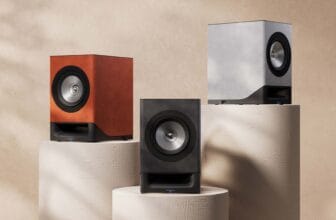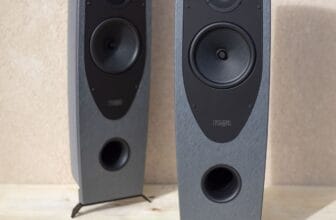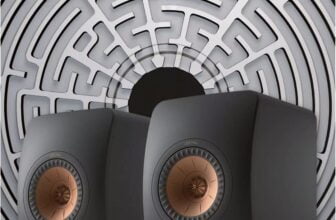Fyne Audio F301 Review
Located outside Glasgow, in a geographical area that’s also home to Linn Products and Tannoy Ltd.—and also near the storied whisky distilleries of Aberfeldy and Blair Atholl—Fyne Audio got off to a fast start. A mere three years after the company’s 2017 founding, Fyne already has distribution deals in 50 countries and offers 24 products in seven series. Read our Fyne Audio F301 Review.
ken micallef
How did they do it? There’s a clue on the company’s homepage, which claims “more than 200 years of experience” among Fyne employees: The founders are a core group of former senior managers from Tannoy Ltd.— including former Tannoy operations director Gabriel O’Donohue, product development director Stuart Wilkinson, and Dr. Paul Mills, who spent 27 years as Tannoy’s director of research and engineering and now serves as Fyne’s technical director.
Those 24 products cover a wide range of price and luxury, from the big, five-figure F1-12 at the top of the line to the small, standmounted F300. The subject of this review, from the F300 series, is Fyne Audio’s second least- expensive speaker, the F301 standmounter.
Design
The F301 is a compact, two-way, ported loudspeaker designed and engineered at Fyne’s headquarters in Lanarkshire, Scotland, and assembled and manufactured in China. (Upper-tier Fynes are manufactured in Scotland.) Tannoy is known for its coaxial drivers, and Fyne’s founders carry on that tradition, but there are no coaxials in this model. The F301 utilizes a 1″ (25mm) polyester-dome tweeter, which the company says produces “a more insightful, detailed sound” than the more common silk dome. The F301 tweeter, which incorporates a neodymium magnet, is protected by a steel-mesh grille with a “phase loss compensator” said to “delay the output from specific areas of
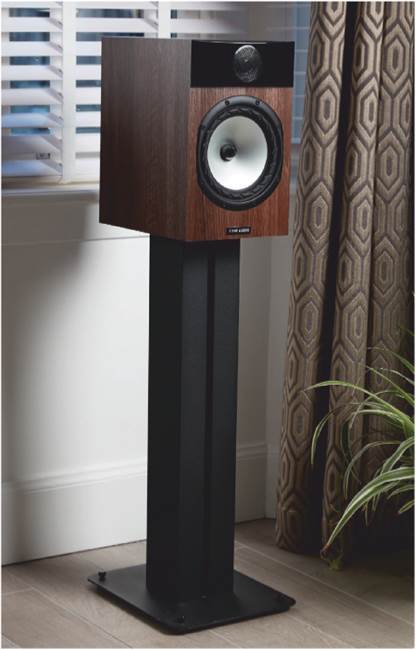
Specifications
Description Two-way, rear-ported, standmount loudspeaker. Drive units: 1″ (25mm) polyester-dome tweeter. 6″ (150mm) multifiber cone woofer. Crossover type: 2nd order low-pass, 3rd order high-pass. Crossover frequency: 3.2kHz. Frequency response: (-6dB typical in room) 44Hz-28kHz. Nominal impedance: 8 ohms. Sensitivity: 89dB/2.83V/m). Recommended amplifier power: 25-100W(RMS). Continuous power handling: 50W (RMS).
Dimensions 11.8″ (300mm) H x 7.5″ (190mm) W x 10.7″ (271mm) D. Weight: 11.7lb (5.3kg).
Finishes walnut, black ash, light oak.
Serial numbers of units reviewed
F80000042190329500921 and …922. Made in China. Approximate number of US dealers: 5. Warranty: Seven years. Manufacturer Fyne Audio Ltd., Suite 42, Grovewood Business Centre, Strathclyde Business Park, Bellshill,
Lanarkshire ML4 3NQ, Scotland, United Kingdom. Tel: (0141) 428-4008. Web: fyneaudio.com.
US distributor:
The Sound Organisation, 1009 Oakmead Dr., Arlington, TX 76011.
Tel: (972) 234-0182.
Web: soundorg.com.
the dome to give a smooth and extended response.”
The matte-silver “multi-fibre” cone of the F301’s 6″ (150mm) mid/bass driver is a blend of paper fibers said by Fyne to be “a proprietary mix, designed to offer stiffness at low frequencies for a piston-like behavior, but also to obtain damping and smooth rolloff in the midrange.” The driver’s synthetic rubber surround is dimpled or fluted at 0.25″ inter- vals—the manufacturer calls this their FyneFlute technol- ogy—which is said to cancel the “mis-termination” effects that occur when energy not fully absorbed by the surround is returned to the cone, causing resonances and colorations. The mid/bass driver incorporates a ferrite magnet system, the rear of which is joined to the cabinet’s internal crossbracing using a “lossy resonant-absorbing” mastic resin, intended to maintain support for the back of the magnet while damping energy fed into the brace. The mid/bass driver is reflex-loaded via a rear-mounted port. The speaker’s stated sensitivity is 89dB/2.83V at 1m, with a nominal impedance of 8 ohms.
The F301’s cabinet is built with CARB-compliant MDF panels that are cross-braced internally. The front baffle and back panel are also made of MDF, glued in place using polyvinyl acetate adhesive. Each F301 cabinet is damped internally using a fill of bonded acoustic fiber. Visually strik- ing—and somewhat novel in my experience—is the convex- curved, 2″-high, 0.5″-deep band of polished acrylonitrile butadiene styrene (ABS) thermoplastic glued to the upper section of the F301’s baffle, where the tweeter is mounted. The ABS housing is “designed to minimize diffraction, [and] is fabricated from polymer chosen for its robust properties and its ability to be aesthetically finished to a high standard,” Paul Mills wrote in an email.
The F301’s back panel holds a single pair of recessed, gold-plated binding posts, positioned below a 2″ wide x 5″ deep port—which, like the tweeter housing, is made from an ABS thermoplastic polymer (although here it is unpolished). A slip of eight peel-off rubber nubs is included for use as feet.
My review pair of F301s were nicely finished in walnut veneer. Magnetically attached grilles were supplied, but I preferred listening without them.
Setup
The F301s didn’t work well in the positions I’d used for the ProAc D2R—see my review in last month’s Stereophile—and the Quad S2 standmount speakers. In those positions the Fynes lacked bass, and their treble sounded forced and thin. Hoping for a stronger sonic foundation, I pushed the speakers closer to the front wall. I ended up with the Fynes 23″ from the front wall and 61″ apart, positioned 75″ from my listening seat, all distances measured from the centers of the front baffles. As predicted by the Fyne manual, toeing in the speakers to aim directly at my listening position provided the best image focus and coherence. My ears were situated roughly 1/2” above the level of the speakers’ tweeters.
As my Thorens TD 124 Mk. II turntable had recently developed a hum, I used my Kuzma Stabi R turntable with Kuzma 4Point tonearm and Hana ML cartridge as the source component for evaluating the Fynes. The Kuzma tonearm’s phono cable was connected to a Tavish Design Adagio phono stage; a one-meter pair of Shindo interconnects connected that phono stage to the inputs of the Cary SLI-80HS and Schiit Ragnarok 2 integrated amplifiers. (I used the Cary’s 8 ohm speaker taps.) Auditorium 23 speaker cables connected the amps to the Fyne Audio F301s. A pair of 24″ Sanus NF24B Natural Foundations wooden speaker stands were used throughout the review period.
Listening
After a break-in period, the Fyne F301s impressed with their exceptional rendering of soundstage width and depth, reasonably wide dynamic range, extended low end (for their size), and exuberant, I-can’t-stop-spinning-records presentation. The Fynes presented a finely layered, spatially convincing soundstage with images that were solid, if small. The F301’s treble could sometimes have a tinge of dryness
Measurements
I used DRA Labs’ MLSSA system to measure the Fyne Audio F301’s farfield behavior with a calibrated DPA 4006 microphone. (I left the vestigial grille that covers the woofer in place for the measurements, as it appears to provide the necessary acoustic environment for the tweeter.) For the speaker’s nearfield response, I used an EarthworksQTC-40 mike, which has a small (0.25″-diameter) capsule.
Although the Fyne F301’s specified sensitivity is a high 89dB/2.83V/m, my estimated sensitivity was slightly lower, at 86.2dB(B)/2.83V/m. The Fyne F301’s nominal impedance is specified as 8 ohms. While the impedance magnitude (fig.1, solid trace) remains above 8 ohms from the upper midrange through to 30kHz, it does drop below 8 ohms in the lower midrange, with a minimum value of 4.77 ohms at 200Hz. While the electrical phase angle (dashed trace) is high at some frequencies, the impedance magnitude is also high at those frequencies. The Fyne F301 will thus be a relatively easy load for the partnering amplifier.
The traces in fig.1 are free from the small discontinuities in the midrange that would imply the presence of panel resonance. However, when I investigated the enclosure’s vibrational behavior with a plastic-tape accelerometer, I found a lowish-Q mode at 410Hz on the sidewalls (fig.2), with some other modes present close to 1kHz. These latter modes are too high in both frequency and Q to affect the Fyne speaker’s sound quality, but I would have expected the lower-frequency mode to give rise to some midrange congestion. It is fair to note, however, that KM didn’t find any problem in this region.
The saddle centered on 51Hz in the impedance magnitude trace suggests that this is the tuning frequency of the port on the Fyne’s rear panel. This is
Stereophile Fyne 301 Impedance (ohms) & Phase (deg) vs Frequency (Hz)
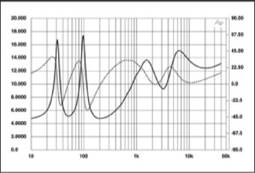
Fig.1 Fyne Audio F301, electrical impedance (solid) and phase (dashed) (2 ohms/vertical div.).
confirmed by the fact that the nearfield response of the woofer (fig.3, blue trace) has its minimum-motion notch at that frequency. (The back pressure from the port resonance holds the cone stationary at the tuning frequency.) The nearfield response of the port (red trace) peaks broadly between 40Hz and 100Hz, with a clean upper frequency rolloff. However, its output is disturbed by a high-amplitude peak at 800Hz. Standing behind the loudspeaker, I could hear this behavior as a whistle imposed on the noise-like MLSSA signal.
The black trace below 300Hz in fig.3 shows the sum of the Fyne’s nearfield woofer and port outputs, taking into account acoustic phase and the different distance of each radiator from a
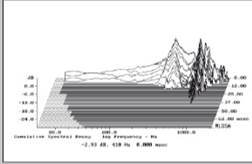
Fig.2 Fyne Audio F301, cumulative spectral-decay plot calculated from output of accelerometer fastened to center of sidewall (MLS driving voltage to speaker, 7.55V; measurement bandwidth, 2kHz).
nominal farfield microphone position. The small excess of upper-bass energy will be due to the nearfield measurement technique, which assumes that the radiators are mounted on a true infinite baffle—ie, one that extends indefinitely in both horizontal and vertical planes.
The Fyne F301’s farfield response, averaged across a 30° horizontal window centered on the tweeter axis, is shown as the black trace above 300Hz in fig.3. It is not as flat as I expected from the speaker’s pedigree. Depending on which frequency the listener takes as a reference, which will be related to the music being played, there is either
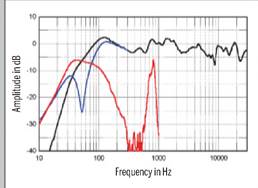
Fig.3 Fyne Audio F301, anechoic response on tweeter axis at 50″, averaged across 30° horizontal window and corrected for microphone response (black), with the nearfield responses of the woofer (blue) and port (red), respectively plotted below 300Hz and 1kHz, and their complex sum (black) plotted below 300Hz.
an excess of energy between 700Hz and 2kHz, or insufficient energy in the midrange, presence, and mid-treble regions. That KM found the 301’s tonal balance “tilted toward the dark side” is probably related to the depressed treble, as is my estimated sensitivity being slightly lower than specified. This graph was taken with sample ‘922; the response of the other speaker, serial number ‘921, was very closely matched below 2kHz and above 5kHz, but the depth of the depression between those regions was 2dB greater.
The plot of the Fyne F301’s horizontal dispersion, referenced to the response on the tweeter axis (fig.4), indicates that the speaker’s output drops off to the sides above 10kHz. Other than the apparent peak at
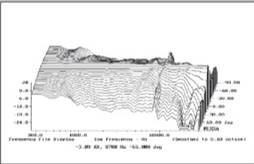
Fig.4 Fyne Audio F301, lateral response family at 50″, normalized to response on tweeter axis, from back to front: differences in response 90-5° off axis, reference response, differences in response 5-90° off axis.
measurements, continued
8.7kHz, which will be due to the on- axis suckout at that frequency filling into the sides, the contour lines in this graph are relatively even throughout the midrange and treble. This will correlate with stable stereo imaging. In the vertical plane (fig.5), the presenceregion depression deepens below the tweeter axis but fills in to some extent 5° above that axis. I note that KM did listen to the F301s with his ears roughly 1/2” above the level of their tweeters.
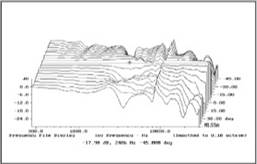
Fig.5 Fyne Audio F301, vertical response family at 50″, normalized to response on tweeter axis, from back to front: differences in response 45-5° above axis, reference response, differences in response 5-45° below axis.
Turning to the time domain, the Fyne F301’s step response on the tweeter axis (fig.6) indicates that the tweeter is connected in inverted acoustic polarity, the woofer in positive polarity. The tweeter’s step, which arrives first at the microphone, has decayed before the woofer’s step starts, but the latter’s decay is overlaid with regular undulations. These correlate with some ridges of delayed energy in the upper midrange in the Fyne’s cumulative
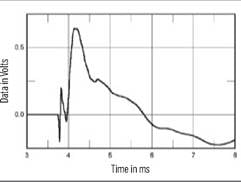
Fig.6 Fyne Audio F301, step response on tweeter axis at 50″ (5ms time window, 30kHz bandwidth).
spectral-decay plot (fig.7). The treble is cleaner in this respect, though the suckout at 8.7kHz is accompanied by another ridge of delayed energy. (As always with my CSD plots, ignore the small ridge just below 17kHz, which is due to interference from the computer monitor’s line-scan frequency.)
Though Fyne Audio’s F301 had some issues on the test bench, these are not unexpected, given the speaker’s affordable price.—John Atkinson
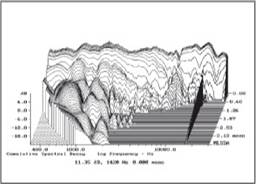
Fig.7 Fyne Audio F301, cumulative spectral-decay plot on tweeter axis at 50″ (0.15ms risetime).
—–
or hardness on brass and strings. Otherwise, the F301s consistently sounded warm and rich for their size.
Paired with the Cary SLI-80HS integrated amplifier and playing Miles Davis’s 1969 stereo release Filles de Kilimanjaro (LP, Columbia CS 9750), the F301s presented the quintet of Miles, Wayne Shorter, Herbie Hancock, Ron Carter, and Tony Williams in vivid miniature. The F301’s treble range gave Miles’s trumpet spice and heat, while the mids helped outline the top end of Carter’s acoustic bass. The Fynes recreated the rumbling lower notes of Carter’s bass—ex- cept that instrument’s very lowest notes—with convincing weight. Tony Williams’s ride cymbal was clean and distinct, surrounded by realistic air, with dryness appropriate to 1960s Zildjian cymbals.
The F301’s spatial performance was apparent when playing Igor Stravinsky’s The Firebird, performed by the London Symphony Orchestra conducted by Antal Dorati (LP, Mercury Living Presence 478-8318, Netherlands pressing, 2015), with images small but realistic. Whether plucked or bowed, string textures were reproduced with visceral intensity. The F301s sometimes made it difficult to distinguish the sounds of instruments from one another in ensemble recordings, but only to a minor degree, never detracting from the musical content. The F301s were fast, fast, fast, with strong bass reproduction, generating a degree of involvement that let me forget, for a moment, my reviewer’s job and flow with the music.
I noted the Fyne’s fine transparency while spinning Analogue Productions’ 45rpm version of Rimsky-Korsakoff’s Scheherazade, by Fritz Reiner conducting the Chicago Symphony (LP, Analogue Productions APC 2446-45). Powering the Fynes with the Schiit Ragnarok 2 integrated amplifier (60Wpc into 8 ohms), I sometimes heard a coarseness in string-section climaxes, which mostly fell on the safe side of the smooth/piercing scale, never crossing the line into forward, spitty, or bright. Flute and oboe were vivid and lifelike, the orchestra’s low end was plummy, with good weight, and the soundstage on this recording was both deep and wide.
Sticking with the Fyne-Schiit pairing, I pulled out a guilty pleasure that may excommunicate me from the cool kids’ listening party. Growing up as I did with rock, then prog rock, then jazz fusion, then pure jazz, I was all in when I first heard the music of Canadian-Italian belter Gino Vannelli. His Powerful People, Storm at Sunup, The Gist of the Gemini, and Nightwalker albums remain, for me, some of the most smartly performed and crafted, and, yes, over-the-top, macho jazz-rock ever recorded. Just stay away from YouTube: You don’t want to see Gino’s marionette dancing circa 1975 if you want to continue to live a normal life.
Recorded in 1976 at George Martin’s AIR studios in London with Gino and brother Joe Vannelli sharing production with Geoff Emerick, The Gist of the Gemini (LP, A&M Records SP4596) sounds like it was recorded in the smaller of AIR’s two large live rooms; it benefits from its natural reverb and long decay trails. A melodramatic love/war protest set to song, the album is a colossal presentation of jazz-rock quartet and full orchestra navigating groundbreaking synthesizer rock (“Love of My Life,” “A New Fix for ’76”), leading to the second side’s “War Suite.”
Driven by Graham Lear’s creative drumming and the resounding timpani strokes of percussionist Richard Baker, and joined to a male choir, orchestra, and even more synthesizers, “War Suite” is operatic, bombastic, and intimate all at once. The Fynes presented this music in all its overblown glory, giving me chills on multiple listenings. After the marchlike orchestral intro, “Prelude to the War,” comes a furious Afro-Cuban rock-to-uptempo-swing blowout, complete with vocal chorus. The Fynes reproduced the song’s stomping drums, bellowing choir, and War of the Worlds- worthy synthesizers with power, impact, and ’70s studio profundity—it was all there through the powerful F301s. I was greatly entertained. The track concludes with a grinding snare drum and synthesizer duel. Here and throughout The Gist of the Gemini, the Fynes recreated the marathon studio experience with a sense of ease, never bending to the power demands, never flattening dynamics, and never squeezing instruments together.
On Relaxin’ with the Miles Davis Quintet (LP, Prestige PRLP 7129, 1958), Paul Chambers’s acoustic bass sounded clear and full of tone, sinewy and agile. But piano, trumpet, and tenor saxophone sounded a little dry. The presentation was very good in every other way, but this dryness robbed the record of some of its humanity.
JMT Productions was a German jazz label founded in 1985 by Stefan Winter, who currently oversees the Winter & Winter label. JMT issued some 90 releases focused on New York’s downtown jazz scene, documenting the early work of Steve Coleman, Cassandra Wilson, Tim Berne, Greg Osby, Paul Motian—JMT lists 10 Motian titles—and others. Though reissued digitally by Winter & Winter, JMT LPs have never been reissued on vinyl. They’re worth searching out, both for their music and as documents of a time in NYC when artistic innovation flowed out of East Village tenements, and rents were cheap.
The label’s very first issue—Steve Coleman Group’s Motherland Pulse (LP, JMT 850001)—joins the trailblazing alto saxophonist with Cassandra Wilson, Geri Allen (RIP), Marvin “Smitty” Smith, Mark Johnson, Lonnie Plaxico, and Graham Haynes for an album of soul-levitating, exploratory jazz. A youthful, playful Wilson graces the buoyant “No Good Time Fairies,” which swings in a peculiar way, like old folks ambling across the street at 4am. The production sounds thick, viscous, humid. The F301s, which consistently presented music in first-row fashion, delivered this sultry jazz with extended bass notes, naturally vivid trumpet, willowy saxophone, and appropriate force. The music had drive through the F301s. Tonal balance was tilted toward the dark side, but that worked well with this music.
The Fyne F301s did a good job navigating the extreme micro and macro dynamics of Act 1 of Wagner’s Die Walktire, with Georg Solti conducting the Vienna Philharmonic (5-LP box set, London Records OSA 1509). A brief introductory section of churning orchestral textures and extreme dynamics, Act 1 has enchanted and haunted me for months. The little Fynes gripped the music and held on, reproducing the large-scaled soundstage with relative ease, and they didn’t totally lose it on the music’s grand climaxes, although there was some fleeting, mild dynamic compression. The Fynes’ clarity and speed let me enjoy the music; I replayed disc one from the box set a number of times before moving on.
While the Fynes consistently produced finely resolved images, a rich midrange, and very good bass for a speaker its size, I could nitpick their tendency toward dryness in the upper frequencies, sometimes making tenor or alto saxophones, cymbals, strings, and brass sound a bit thin. Careful system matching—perhaps pairing the Fynes with the NAD C 328, Heed Audio Elixir, or Outlaw Audio RR2160 integrated amplifiers —is essential to make these capable bookshelf speakers shine.
The only other bookshelf speakers on hand for comparison were the Quad S2s (87dB at 8 ohms). The Quad is a more refined, harder-to-drive—and more expensive—bookshelf speaker than the Fyne F301. The Quad works great with jazz, orchestral music, female vocals, and all acoustic music. It’s a little laid back, a little pipe-and-slip- pers, but it’s sweet and assured. The F301, by comparison, is loads of fun, jumps higher, pounds its chest more fervently, and is as comfortable channeling ZZ Top on “La Grange” as placing Birgit Nilsson singing Wagner.
Conclusion
The Fyne Audio F301 loudspeakers punch way above their price point. Their ability to cast a wide, deep soundstage with super imaging was as good as any bookshelf speaker I’ve had in house. Their serious jump factor and
meaty bass frequencies were a consistent treat. The speaker’s slightly dry upper frequencies demand careful amplifier matching, but otherwise, for a sub-$ speaker, there’s not a lot to criticize. Coherent to their core, they never made me focus on a single aspect of their performance but led me deeply into the whole of the music. Whatever the reason, the F301s are an unmitigated success for the young Scottish company. I can’t wait to hear its elder siblings.
Associated equipment
Analog sources Kuzma Stabi R turntable & Kuzma 4Point 11″ tonearm; Hana ML MC phono cartridge.
Preamplification Tavish Audio Design phono preamplifier. Integrated amplifiers Schiit Audio Ragnarok, Cary Audio SLI-80HS.
Loudspeakers Quad S2.
Cables Interconnect: Shindo Laboratory, Triode Wire Labs Spirit II. Speaker: Auditorium 23. AC: Triode Wire Labs Obsession NCF power cord, manufacturers’ own. Accessories IsoTek EVO3 Aquarius line conditioner, Salamander five-tier rack; IKEA Aptitlig bamboo chopping boards (under preamp, power amps); Mapleshade maple platform (15″ x 12″ x 2″, under turntable), mahogany blocks (2″ x 2″ x 0.5″); 3″-thick studio-treatment foam damping (ceiling, walls).
Listening room 12′ L x 10′ W x 12′ H, system set up along long wall; suspended wood floor, 6″-thick walls (plaster over 2×4), wood-beamed ceiling.—Ken Micallef
Fyne Audio F301 Bookshelf Speakers - LWalnut
- Dimensions (H x W x D) 300 x 190 x 271 mm (11.8 x 7.5 x 10.7")
- Weight 5.3kg (11.7 lb)
- Crossover Frequency 3.2kHz
- Reccomended Amplifier Power (Watt RMS) 25-100



